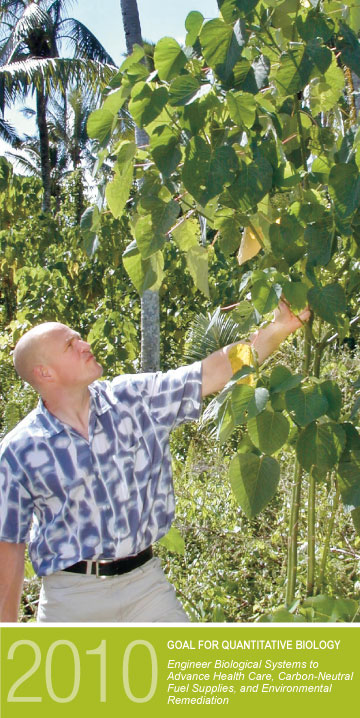
Living Systems and Quantitative Biology
On the Path to a Healthier World
At the start of the 21st century, scientists now have the tools needed to study living cells at the molecular and atomic levels. The information gained from this ever-expanding array of tools is opening entire new avenues for the prevention and control of some of our deadliest and most pernicious diseases, including major forms of cancer, HIV-AIDS, and malaria. It is also paving the way for learning to repair or replace damaged cells and tissue. The same tools that promise so much for the life sciences offer new possibilities in other arenas as well, most notably carbon-neutral energy production, environmental remediation, and homeland security.
Right: Mamala trees like this, found in Samoa, produce a promising anti-AIDS drug, originally discovered by Samoan healers, called prostratin. Chemical Engineer Jay Keasling, pictured, is synthesizing genes from the mamala to produce a cheaper and more plentiful synthetic version of prostratin. Keasling is the director of Berkeley Lab's Physical Biosciences Division, and also heads the Lab's new Synthetic Biology Department, the first of its kind in the world.
Among the tools now available are spectroscopy techniques for “stopping the action” on biological processes that can take place within a few millionths of a billionth of a second; imaging techniques for capturing the intricate architecture of the proteins that set the composition and chemistry of living cells; genetic sequencing and engineering techniques that can be used to identify and manipulate genes; and new algorithms for faster, more powerful computational resources that enable increasingly sophisticated simulations of the machinery of life.
Berkeley Lab researchers have been at the forefront in the development and use of these tools. Scientists here were major participants in the Human Genome Project, and, through participation in the Joint Genome Institute, are continuing the task of sequencing the DNA of scientifically important organisms and applying this data to the ongoing search for new genes and their associated proteins. Our scientists — often in close collaboration with researchers on the University of California campuses of Berkeley and San Francisco, the California Institute for Quantitative Biomedical Research (QB3), and elsewhere — are unraveling such mysteries as how individual cells interact with each other and their environment to maintain the physical well-being of their host organism.
